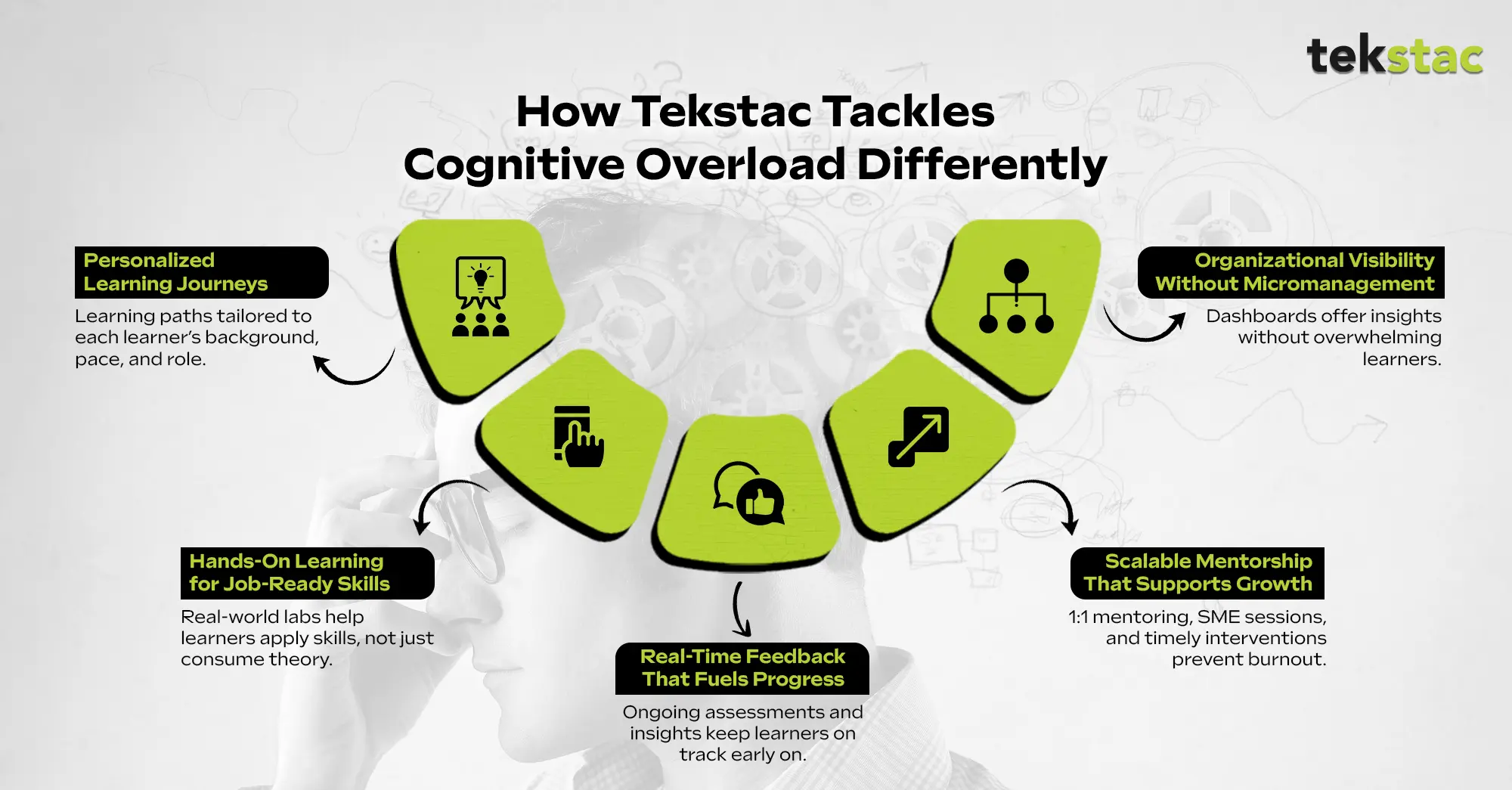Cognitive Overload Challenge: Why Tekstac Wins Where Traditional LMS Fail
August 26, 2025

It’s no surprise that technology is advancing faster than ever before.
Every day, teams learn new tools, programming languages, cloud platforms, and frameworks to keep up. The pressure to continuously upskill, reskill, and adapt is very high.
Despite all the learning platforms, content libraries, and online courses available, many organizations struggle with cognitive overload. It actively harms motivation, engagement, and retention.
Most platforms keep adding more and more videos, content, and courses, forgetting that the human brain does not thrive on abundance, but instead on clarity.
And this is where Tekstac does things differently. But before that, let’s explore what cognitive overload means.
What Exactly Is Cognitive Overload?
Cognitive overload happens when the brain is overwhelmed with more information than it can reasonably process. Rather than laziness or a lack of willpower, it’s more about bandwidth, which can be stretched thin.
For example, imagine a learner who’s working with legacy systems, upskilling in cloud tech, preparing for certifications, and still trying to deliver on business goals. If we add to this a cluttered LMS interface with hundreds of unstructured modules on top, it becomes cognitive overload.
This results in burnout, drop-offs, minimal knowledge retention, and frustrated teams. This is the real cost of cognitive overload, and it’s the cost most traditional LMS platforms ignore.
Why LMS Platforms Contribute to Cognitive Overload
Learning Management Systems came into prominence as a way to organize and distribute training content. However, most of these systems were built decades ago for compliance training, not rapid tech skill development.
Below are the reasons why traditional LMS platforms fall short when it comes to employee training and development, causing cognitive overload:
1) Content dumping without context
Many LMSs typically offer learners a massive library of courses, videos, documents, and quizzes. The problem here is that there’s little guidance on what to choose or why. This is similar to walking into a gigantic bookstore without any recommendations, maps, or curated sections. Similarly, employees feel lost, overwhelmed, and eventually walk away. This is because they see hundreds of modules, many irrelevant to their job or skill level, and realize that there’s no actual career path forward.
2) Lack of role-based personalization
In any organization, no two tech roles are the same. A data scientist has very different learning needs than a systems administrator. Yet, LMS platforms treat everyone like they are learning the same thing, thereby wasting valuable time and also adding to the mental burden of sorting through what is useful and what is not.
3) Reliance on passive learning formats
As mentioned, most LMS content consists of videos, slide decks, and PDFs. Passive learning demands a lot of mental effort without much interaction, which is tough to maintain, especially when working on day-to-day responsibilities. Without proper opportunities to practice the skills learned, learners will not be able to retain the knowledge or apply it confidently.
4) No meaningful feedback and assessments
Some platforms either lack meaningful assessments or rely on generic, manually graded quizzes that do not provide timely that do not always provide actionable feedback. When learners fail to understand where they stand or what to focus on next. This cognitive overload drains motivation and makes the learning experience confusing.
5) No adequate access to mentors and coaches
When challenges arise, especially in complex tech learning, learners may be left to figure out on their own. This is because traditional learning platforms leave learners with little to no access to mentors, coaches, or communities. This can amplify cognitive overload and the risk of burnout as well.
6) Siloed learning activity
Most importantly, many LMS platforms disconnect learning from real business goals or project demands. Learners may complete courses merely because they were assigned, feeling it as an obligation rather than a pathway to growth.
Ultimately, all the above factors combine to create an environment that causes cognitive overload.
How Tekstac Addresses Cognitive Overload Differently
While most platforms aim to treat the symptoms of cognitive overload via shorter videos, better UI, and nudges to take breaks, Tekstac tackles the root causes by rethinking how content is delivered, practiced, assessed, and supported.

1. Built-in Learning Intelligence That Personalizes the Journey
Cognitive overload arises when every learner is forced down the same path, regardless of background, goals, or pace. Tekstac helps flip that through:
Custom learning paths: Be it a college student being prepared for onboarding or a full-stack developer upskilling for an upcoming project, with Tekstac, organizations can personalize learning tracks with only the relevant content.
AI-powered recommendations: Tekstac adapts the learner journey depending on performance and feedback, thereby suggesting remedial content, skipping what the employee already knows, and encouraging where support is needed.
Pre-onboarding to project readiness: Learning is not dumped on users in one go, but rather it’s sequenced smartly from foundational to advanced with ample opportunities to show application along the way.
Result: Learners will no longer drown in irrelevant content. Each user is shown what they need, when they need it.
2. Practice-first Model That Reduces Theoretical Fatigue
Reading documentation or watching lectures can only go so far. The real overload kicks in when learners cannot seem to connect theory to application.
Immersive hands-on labs: Tekstac’s lab environment mirrors real-world systems, right from databases to cloud infrastructure. Hence, learners learn by doing.
Lab-as-a-service: No external setup is needed. Learners need to just log in, practice, and build muscle memory.
Project-specific training: Organizations can deploy labs aligned to their tech stack, thereby making sure it is relevant and application-ready from day one.
Result: This way, learning is anchored in action. This improves retention and reduces cognitive overload or fatigue caused by passive intake.
3. Built-in Feedback Loops to Prevent Overload Creep
We might observe that some learning platforms assess only at the end, leading to binge-learning followed by failures. Here’s how Tekstac helps overcome this:
Auto-evaluated assessments along the way: Each module ends with quizzes or code checks that immediately allow learners to understand where they fell short.
Video and scenario-based assessments: Real-world judgment is tested instead of just memory recall.
Plagiarism checks and reliability index: Removes blind spots in assessment credibility. This enables more honest learning loops.
Result: Learners stay calibrated throughout instead of discovering gaps too late in the learning journey.
4. Mentorship and Intervention That Humanize the Experience
One of the biggest causes of cognitive overload is the feeling of being stuck and not supported. Tekstac handles this with scalable human touchpoints.
Mentor marketplace and 1:1 connects: Learners can engage with experts directly to resolve any blockers.
SME sessions and hackathons: Keeps motivation high and concepts applied.
Automated/manual learning interventions: Based on learner data, facilitators can step in when progress slows down and before employee frustration sets in.
Result: This way, learners never feel isolated. The system anticipates where support is required before burnout occurs.
5. Organizational Oversight Without Micromanagement
Leaders drown learners in content, hoping something will stick. Tekstac enables smarter program management.
Skill inventory visibility: Know who is learning what, and how they’re progressing, at any time.
Custom dashboards and predictive analytics: Spot high performers, identify gaps, and align training to project demand.
Audit trails and accountability: All activity is logged, but not surveilled. This helps build trust without compromising on standards.
Result: Learning is made more accountable.
What Cognitive-Ease Learning Looks Like in Action: Real-World Scenarios with Tekstac
Theory can only go so far. To really understand how cognitive-friendly learning transforms skill development, let’s walk through real-world use cases where Tekstac shapes how talent upskills.
Scenario 1: Onboarding 200 Fresh Graduates in Emerging Tech
Let’s say an IT consulting & services company need to onboard and skill 200 freshers on Python, cloud computing, and containerization in just 6 weeks. Traditional LMS-based training with heavy video lectures, PDFs, and scattered lab access had failed. Learner dropouts were high. Completion didn’t translate to readiness.
How Tekstac helped:
- Mapped 6-week outcomes into progressive learning paths, with daily 60-minute capsules (including theory, practice, and assessment).
- Each module was goal-oriented, focusing on job-critical outcomes.
- Cognitive fatigue was reduced through clear structure, active recall via quizzes, and peer discussion spaces.
- Mentor escalations dropped by 40%, and 96% of learners were project-deployment-ready by Week 7.
Cognitive outcome: Learners were focused, confident, and retained more because they were never overloaded to begin with.
Scenario 2: Upskilling Experienced Developers on New Stack Without Hurting Productivity
A tech product company wanted to reskill 50 backend developers on a new microservices architecture while they continued working full-time. Long training hours or forced weekend bootcamps had led to resistance before.
Tekstac helped in the following ways:
- Learning was broken into 30-minute micro-paths that fit into existing workdays.
- Labs were cloud-based, so developers didn’t have to waste time setting up environments.
- Weekly performance snapshots gave team leads visibility into progress without pressuring learners.
Cognitive outcome: This led to zero dropouts, and developers applied what they learned directly to upcoming product modules.
Final Word: Reduce Cognitive Overload, Accelerate Readiness
Cognitive overload, when unaddressed, can be the blocker behind most failing learning programs. It can show up in low completion rates, poor retention, and that frustrating gap between training and real-world application. Most companies may not even realize that it’s happening.
Here, the solution is a better design rather than more content. Learning must be structured around how the human brain works, meaning that it must be layered, contextual, and purposeful. Tekstac addresses these challenges by curating learning paths, delivering hands-on practice and feedback, and so on, thereby ensuring that learners walk away with job-ready skills.
Organizations that are looking to create a workforce that learns faster, retains more, and applies with impact it’s effective to start by fixing the learning experience itself.





